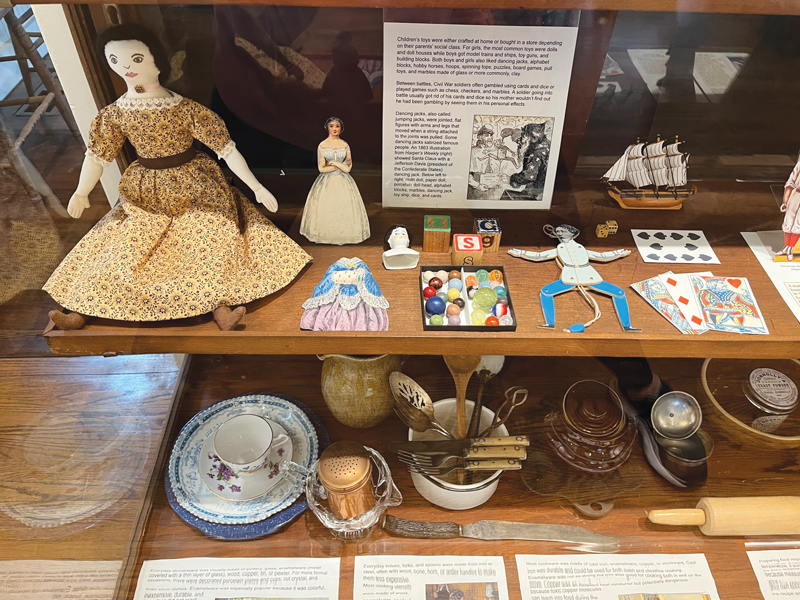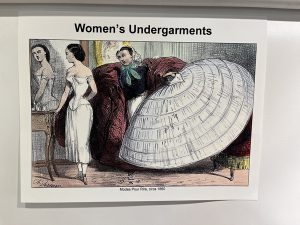Museum exhibit time travels back to Clayton’s ‘golden days’

CLAYTON, CA (Mar. 16, 2023) — In the new exhibit “Life in Clayton 1850-1870” at the Clayton Museum, curator Nancy Niemeyer shines a spotlight on ordinary people doing ordinary things.
“I’ve always been fascinated with how ordinary people lived at various times in history, because I think that’s really relatable to most people. I just found it so interesting, and I thought other people might as well. It’s the most fun part of history to me,” Niemeyer says.
She calls the 1850-1870 timeframe Clayton’s “Golden Age.”
“It’s also the height of the Gold Rush, so it’s about seeing how people in California lived then,” she says.
This is her second exhibit for the museum, after curating the farming display last year. She began working on “Life in Clayton” during the early days of the pandemic, noting it was something she’d always wanted to do.
Bringing history to life
Through the California Digital Newspaper Collection, especially the Contra Costa Gazette, she had ample historical information to create wall-mounted displays with stories and photos – but she was short on actual artifacts.
“The problem with trying to come up with things to illustrate a period in history that was that long ago is that there just isn’t much there. I did the research and tried to find things that probably would have existed back then. For instance, I made a cloth doll in the style of what an 1860s mother would make for her daughter,” she says. “And there is a display case with items that illustrate things like cooking, food, toys, some photography.”
 Visitors can also see what women’s underwear would have looked like in that era. “I think anybody who watches things like ‘Gone with the Wind’ wonders what is under those dresses. We have a 3-D model showing the corset, the hoop skirt, the split drawers.”
Visitors can also see what women’s underwear would have looked like in that era. “I think anybody who watches things like ‘Gone with the Wind’ wonders what is under those dresses. We have a 3-D model showing the corset, the hoop skirt, the split drawers.”
“You know, those hoop skirts were very dangerous,” says JoAnn Caspar, vice president of the Clayton Historical Society. “They would catch on fire sometimes, or they would knock kids over when they turned around.”
Artistic inspiration
Curating for the museum showcases the artist side of Niemeyer, who had a 25-year career as an agricultural biologist for the county.
“Costuming, jewelry, colored pencil drawings – pretty much any kind of artwork you can imagine, I’ve probably done it at some point or another,” she says, adding that her knowledge of period clothing comes from dressing up for the Dicken’s Fair at the Cow Palace.
She emphasizes the importance of focusing on day-to-day life instead of key historical dates. “Most museums skip the fun stuff – what songs were people playing, what they did for fun. This is the fun part of history that they never, ever cover in your history classes.”
Niemeyer just can’t talk about the exhibit without using the word “fun.” Neither can Caspar, who noted that it drew in “a ton of people” on the last Sunday of February.
“There’s a lot about the medicine, what they ate. There is a lot of reading – but it’s interesting reading. I like it a lot,” says Caspar.
Tales from the shady side
Niemeyer tells of a doctor who set up shop in Clayton, claiming to be able to cure all illnesses using electricity. “Unfortunately, I think nobody was really impressed. He stayed only about six months before heading back to San Francisco.”
And then there was a wedding scam.
“A long-time bachelor was very attracted to this lady from San Francisco. He had some female friends determine if she was interested in marrying him. She said yes. They had a big pre-wedding meal at Joel Clayton’s house and everybody donated food. Then she got up and said, ‘Oh, actually, I’m already married and I never got a wedding feast, so I just wanted to have one.’ ”
For Niemeyer, the exhibit shows that human nature doesn’t really change.
“I hope that people will come see it and realize that people in the past were like us – they just had different living conditions. I think it will offer insight into how people lived back then.”
“Life in Clayton 1850-1870” will run through the rest of 2023. The museum is open 2-4 p.m. Wednesdays and Sundays at 6101 Main St., Clayton. For more information on the museum and the Historical Society, visit claytonhistory.org.

Bev Britton
Bev Britton graduated with a degree in journalism from the University of North Dakota and moved to the Bay Area with her soon-to-be husband Jim in 1986. She was features editor at the Contra Costa Times in Walnut Creek before becoming managing editor of the Contra Costa Sun in Lafayette in 1995. She retired from newsrooms in 2001, but an ad for the Clayton Pioneer drew her back in. The family moved to Lake Wildwood in the Gold Country a few years ago - but working at the Pioneer keeps her in touch with her old neighborhoods in Concord and Clayton.



